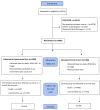Efficacy of Teleconsultation Versus Usual Care in Improving Quality of Life Among Geriatric Patients Aged 60 and Above: A Randomized Controlled Trial
- PMID: 39360076
- PMCID: PMC11446495
- DOI: 10.7759/cureus.68476
Efficacy of Teleconsultation Versus Usual Care in Improving Quality of Life Among Geriatric Patients Aged 60 and Above: A Randomized Controlled Trial
Abstract
Introduction The geriatric population, aged 60 years and older, is rapidly growing worldwide. This demographic shift has led to a higher prevalence of chronic diseases, comorbidities, and functional impairments, placing immense pressure on healthcare systems. Teleconsultation, which uses telecommunication technologies to deliver healthcare services remotely, offers a potential solution. This study aimed to assess the efficacy of teleconsultation versus usual care in improving the quality of life among the geriatric population aged 60 years and older. Methods A parallel, randomized controlled trial with a 1:1 allocation ratio was conducted. Eligible participants, aged 60 and above, were recruited at the triage emergency department (ED) following a baseline eligibility assessment. Inclusion criteria included the ability to communicate in English or Hindi, possession of International Organization for Standardization (ISO-certified) instruments for self-monitoring, and willingness to comply with study procedures and provide written consent. Participants were randomly assigned to experimental and control arms using a computer-generated sequence, with allocation concealment achieved through sequentially numbered opaque sealed envelopes (SNOSEs), which were opened in front of participants after obtaining baseline data. A total of 2,000 participants (1,000 per arm) were enrolled and randomly assigned to either the teleconsultation or usual care group. Results In the teleconsultation group (n=1,000), 36.5% of participants (365) were female and 63.5% of participants (635) were male. Similarly, in the usual care group (n=1,000), 37.1% of participants (371) were female and 62.9% of participants (629) were male. The teleconsultation group significantly outperformed the usual care group in several domains pre-intervention, with higher mean scores in the physical health domain (11.16 vs. 10.96, P = 0.009), psychological domain (11.74 vs. 11.62, P = 0.020), and environment domain (12.44 vs. 12.26, P = 0.0001). No significant difference was observed in the social relationships domain (P = 0.452). The teleconsultation group significantly outperformed the usual care group in all domains post-intervention, with higher mean scores in the physical health domain (14.49 vs. 12.74), psychological domain (13.75 vs. 12.35), social relationships domain (14.05 vs. 12.90), and environment domain (13.91 vs. 12.94) (P < 0.001 for all). Conclusion These findings suggest that teleconsultation significantly improves the quality of life for elderly patients by providing a more accessible and convenient means of healthcare delivery and addressing the physical, emotional, and social challenges associated with chronic illnesses.
Keywords: geriatric population; quality of life; randomized controlled trial; teleconsultation; usual care.
Copyright © 2024, Mahala et al.
Conflict of interest statement
Human subjects: Consent was obtained or waived by all participants in this study. Institute Ethics Committee, All India Institute of Medical Sciences (AIIMS) Rishikesh issued approval AIIMS/IEC/21/239. Animal subjects: All authors have confirmed that this study did not involve animal subjects or tissue. Conflicts of interest: In compliance with the ICMJE uniform disclosure form, all authors declare the following: Payment/services info: All authors have declared that no financial support was received from any organization for the submitted work. Financial relationships: All authors have declared that they have no financial relationships at present or within the previous three years with any organizations that might have an interest in the submitted work. Other relationships: All authors have declared that there are no other relationships or activities that could appear to have influenced the submitted work.
Figures
Similar articles
-
Behavioural interventions for type 2 diabetes: an evidence-based analysis.Ont Health Technol Assess Ser. 2009;9(21):1-45. Epub 2009 Oct 1. Ont Health Technol Assess Ser. 2009. PMID: 23074526 Free PMC article.
-
Antiviral and immunomodulatory interferon-beta in high-risk COVID-19 patients: a structured summary of a study protocol for a randomised controlled trial.Trials. 2021 Sep 3;22(1):584. doi: 10.1186/s13063-021-05367-6. Trials. 2021. PMID: 34479601 Free PMC article.
-
Safety and Efficacy of Imatinib for Hospitalized Adults with COVID-19: A structured summary of a study protocol for a randomised controlled trial.Trials. 2020 Oct 28;21(1):897. doi: 10.1186/s13063-020-04819-9. Trials. 2020. PMID: 33115543 Free PMC article.
-
Tailored or adapted interventions for adults with chronic obstructive pulmonary disease and at least one other long-term condition: a mixed methods review.Cochrane Database Syst Rev. 2021 Jul 26;7(7):CD013384. doi: 10.1002/14651858.CD013384.pub2. Cochrane Database Syst Rev. 2021. PMID: 34309831 Free PMC article.
-
Telephone interventions, delivered by healthcare professionals, for providing education and psychosocial support for informal caregivers of adults with diagnosed illnesses.Cochrane Database Syst Rev. 2019 May 14;5(5):CD012533. doi: 10.1002/14651858.CD012533.pub2. Cochrane Database Syst Rev. 2019. PMID: 31087641 Free PMC article.
References
-
- A novel emergency department-based telemedicine program: how do older patients fare? Greenwald PW, Stern M, Clark S, et al. Telemed J E Health. 2019;25:966–972. - PubMed
-
- A review of patient satisfaction and experience with telemedicine: a virtual solution during and beyond COVID-19 pandemic. Nanda M, Sharma R. Telemed J E Health. 2021;27:1325–1331. - PubMed
-
- Ghimire K, Dahal R. StatPearls [Internet] Treasure Island, FL: StatPearls Publishing; 2024. Geriatric care special needs assessment. - PubMed
LinkOut - more resources
Full Text Sources

